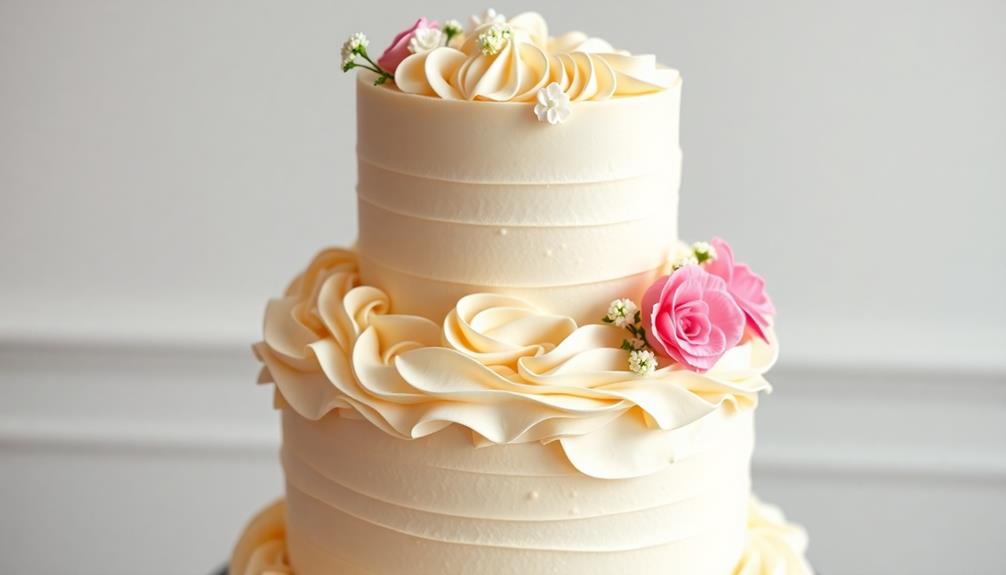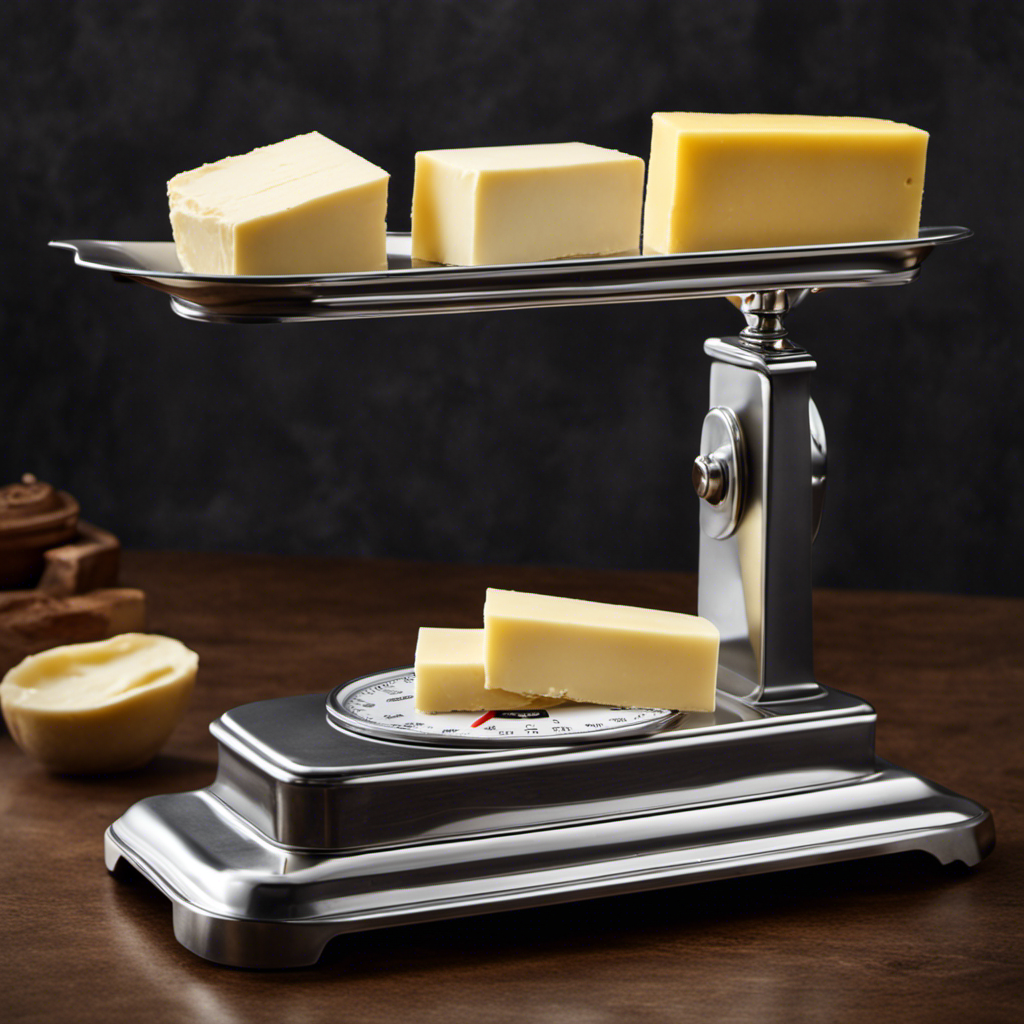To store specialty butters and keep their flavors intact, place them in airtight containers and store them in the refrigerator, ideally between 32°F and 40°F. Avoid humidity by keeping them in a cool, dark place, away from sunlight and heat sources. If you want to extend their shelf life, consider freezing them. Cut the butter into portions, wrap each piece tightly, and use airtight freezer bags. Always label your packages with the butter type and date. If you notice any signs of spoilage like off smells or discoloration, it's best to toss them. There's much more to explore about storing butters effectively.
Key Takeaways
- Store specialty butters in a cool, dark place, ideally in the refrigerator to preserve flavor and extend shelf life.
- Use airtight containers like glass jars or BPA-free plastic to prevent oxidation and spoilage.
- For long-term storage, freeze butter in portioned sizes wrapped tightly to prevent freezer burn.
- Label containers with the type of butter and date made/opened for easy identification and inventory management.
- Regularly check for signs of spoilage, such as off smells, discoloration, or mold, and discard if any are present.
Types of Specialty Butters

When it comes to specialty butters, what exactly should you know about the different types? Specialty butters come in various flavors and compositions, each offering unique culinary experiences.
One popular type is herb-infused butter, which combines fresh herbs like basil or rosemary with butter, adding depth to dishes like grilled meats and vegetables.
Another option is garlic butter, a favorite for its rich, savory profile, perfect for spreading on bread or melting over seafood.
You might also encounter compound butters, which blend flavors such as citrus zest, spices, or even sweet ingredients like honey for dessert applications.
If you're in the mood for something a bit richer, truffle butter is a luxurious choice, combining the earthy aroma of truffles with creamy butter, elevating any dish it touches.
For a dairy-free alternative, consider vegan butters made from oils like coconut or avocado, providing flavor without the dairy.
Ideal Storage Conditions

Storing specialty butters properly is essential for maintaining their flavor and quality. To achieve this, you'll want to control the temperature and humidity of the storage environment. Ideally, specialty butters should be kept in a cool, dark place, away from direct sunlight and heat sources. A refrigerator is often the best choice, as it helps preserve their unique flavors and extends their shelf life.
Additionally, using proper storage techniques can further enhance the longevity and taste of your butters.
When storing, aim for a temperature between 32°F and 40°F (0°C to 4°C). This range keeps the butter solid but still spreadable. Be mindful of humidity too; excessive moisture can lead to spoilage or unwanted flavors. If your refrigerator tends to be humid, consider using a separate container to protect the butter.
If you plan to store your specialty butter for an extended period, consider freezing it. Freezing can preserve its quality for months, but make sure to thaw it in the fridge to maintain the ideal texture.
Proper Container Choices

Choosing the right container for your specialty butters can greatly impact their freshness and flavor. Start by selecting airtight containers, as they prevent exposure to air, which can cause oxidation and spoilage. Glass jars with tight-fitting lids are excellent choices since they're non-reactive and won't impart any unwanted flavors.
If you prefer plastic, make certain to use BPA-free containers designed to be airtight. They're lightweight and easy to handle, but check for any signs of wear or damage, as this can compromise their sealing ability.
For smaller portions, consider using silicone molds. These allow you to portion out your specialty butters easily, and you can pop them out as needed. Just make sure they're stored in a larger airtight container to maintain freshness.
Avoid using containers that previously held strong-smelling foods, as they can transfer unwanted flavors to your butters.
Finally, label your containers with the type of butter and the date you made or opened it. This way, you'll always know what you've got and how fresh it is.
With the right container, your specialty butters will stay delicious and ready for use!
Freezing Techniques

Freezing specialty butters is a fantastic way to extend their shelf life while preserving their flavors. Before you freeze, portion the butter into manageable sizes. This makes it easier to defrost only what you need later. You can use ice cube trays, silicone molds, or parchment paper to shape the butter into smaller pieces.
Once you've portioned the butter, wrap each piece tightly in plastic wrap or aluminum foil to prevent freezer burn. If you prefer, you can also place the wrapped portions in an airtight freezer bag or container.
Don't forget to label your packages with the date and type of butter, so you can keep track of what you have on hand.
When you're ready to use the frozen butter, simply transfer the desired amount to the fridge to thaw overnight or leave it at room temperature for a couple of hours. Avoid refreezing thawed butter, as this can affect its texture and taste.
Signs of Spoilage

Even with proper freezing techniques, specialty butters can still spoil over time. To keep your butters safe for use, you need to recognize the signs of spoilage. Here are some key indicators to watch for:
| Signs of Spoilage | Description | Action to Take |
|---|---|---|
| Off Smell | A sour or rancid odor indicates spoilage. | Discard immediately. |
| Discoloration | Any unusual color changes, especially dark spots. | Evaluate freshness; if severe, throw it out. |
| Texture Changes | Graininess or separation of fat can signal spoilage. | If texture is off, it's better to toss it. |
| Mold Growth | Visible mold, whether on the surface or throughout. | Dispose of the butter right away. |
| Unpleasant Taste | A bitter or strange flavor when used. | Don't consume; discard it. |
Frequently Asked Questions
Can I Use Specialty Butters in Baking Recipes?
Absolutely, you can use specialty butters in baking recipes! They'll add unique flavors and enhance your dishes. Just keep in mind their properties, as some may melt differently or affect the texture of your baked goods.
How Long Can Specialty Butters Be Stored at Room Temperature?
Think of specialty butters as delicate flowers needing care. At room temperature, they can last about one to two days, but it's best to refrigerate them for longer freshness and flavor retention.
Do Specialty Butters Need to Be Vacuum Sealed?
You don't need to vacuum seal specialty butters, but doing so can extend their freshness. Just guarantee they're stored in a cool place, tightly covered, to maintain their flavor and texture for longer.
Can I Mix Different Types of Specialty Butters Together?
Imagine swirling rich truffle butter with zesty herb-infused goodness. You can mix different specialty butters together! Just guarantee the flavors complement each other, creating a delightful spread that's bursting with creativity and deliciousness. Enjoy experimenting!
Are There Health Benefits to Using Specialty Butters?
Yes, specialty butters can offer health benefits. They often contain essential nutrients and healthy fats that support heart health and enhance flavor. Just remember to enjoy them in moderation for balanced nutrition.
Conclusion
Storing specialty butters might seem tricky, but it's easier than you think! With the right conditions and containers, you can keep them fresh and flavorful. Don't let the fear of spoilage stop you from enjoying these delicious treats. Remember, every time you open a jar, you're indulging in a little luxury that enhances your meals. So go ahead—store your butters with confidence and savor every bite without worry! You deserve it!










